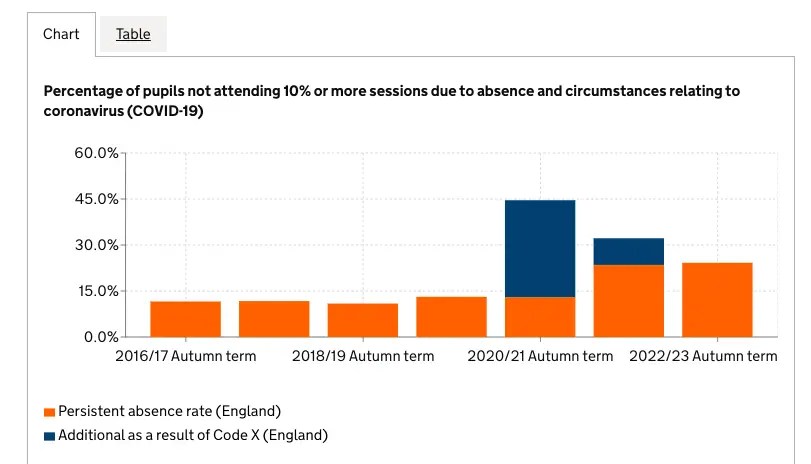Last Updated on July 19, 2023 by Karl Thompson
The overall absence rate for schools in the Autumn term of 2022-2023 was 7.5%. This was an increase from the previous term and from the pre-covid absence rate of just under 5%.

In the Autumn term of 2022/2023, the persistence absence rate was 24.2%, compared to just 11.6% in 2016/17. This means 24.2% of pupils missed 10% or more of their lessons, with illness being the main reason.

Why are school absence rates higher?
There are several possible reasons including:
- higher rates of illness, including the persistence of covid
- poor mental health
- The cost of living crises
- more parents working from home
- A new norm of ‘hybrid schooling’…?
Higher rates of illness
Illness is the main reason for absence provided, and there have been relatively high numbers of flu cases and of course Covid is still around.
However, ‘illness’ is the standard excuse parents will use. There may be deeper reasons, which I think are the main cause.
Poor mental health
The Children Society’s Good Childhood Report of 2022 reported that children today are 50% more likely to have mental health problems compared to three years ago.
Unhappy and anxious children are more likely to want to avoid going to school!
This correlates perfectly with the increase in persistent absence, and is certainly something worth exploring further.
The Cost of Living Crisis
According to Joseph Rowntree, it is the poorest 20% of households that are suffering the most from increasing inflation, with many of them struggling to pay the bills and feed their children.
Poverty means poor diets and colder homes, which could feed into higher illness rates and higher absence rates, it could also mean inability to pay for the hidden costs of education such as school uniforms and stationary which could lead to absences due to a sense of shame.
More parents working from home
Hybrid working is increasingly common post-covid, and now that one parent is more likely to be home one or more days of the week, they are more able to look after children who are sick or ‘sick’.
A new norm of hybrid education?
Following covid and children having had time of school, some parents may simply not see the need for their children to be in school 5 days a week.
To my mind this makes sense. Many parents feel the benefits of being home 2-3 days a week and in the office for the rest of the week, they may feel their children could benefit from a similar pattern, especially because schools are now set-up to provide extra support for absent children following Covid.
This final point would be worth researching.
Signposting
This material is mainly relevant to the education module within A-level sociology.
